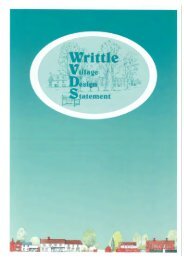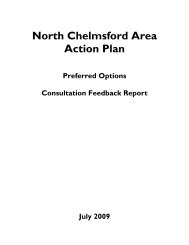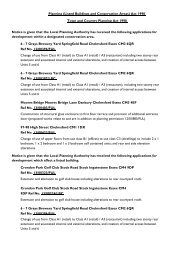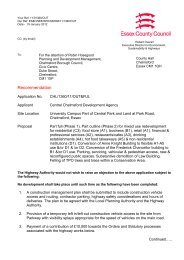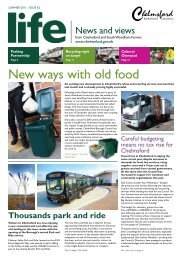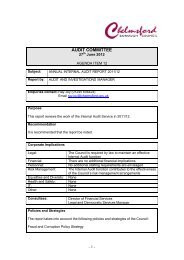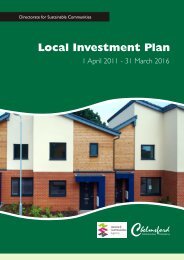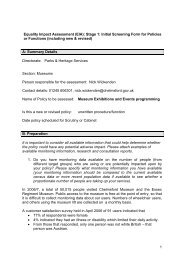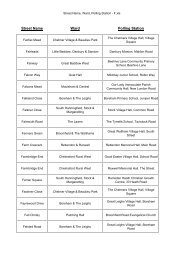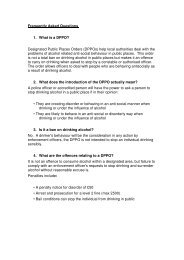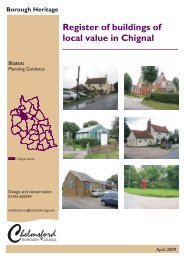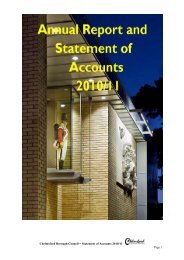Landscape Character Assessment - Chelmsford Borough Council
Landscape Character Assessment - Chelmsford Borough Council
Landscape Character Assessment - Chelmsford Borough Council
You also want an ePaper? Increase the reach of your titles
YUMPU automatically turns print PDFs into web optimized ePapers that Google loves.
HISTORIC LANDSCAPE CHARACTER AREAS METHODOLOGYThis methodology for the definition of Historic <strong>Landscape</strong> <strong>Character</strong> Areas (HLCAs) was agreed withEssex County <strong>Council</strong> Historic Environment Unit (Nigel Brown) and English Heritage (David Went).The methodology involved five broad stages:Addition of supplementary datasets to the Essex Historic <strong>Landscape</strong> <strong>Character</strong>isation (HLC)dataset;Creation of outline areas;Review in relation to work undertaken by Essex County <strong>Council</strong>;Description and review;Overlay of <strong>Landscape</strong> <strong>Character</strong> Areas.Addition of Supplementary Datasets to HLC DatasetTwo additional supplementary datasets were included within the analysis:Ancient Woodland data (from English Nature); andRegistered Historic Park and Garden data (from English Heritage).Creation of Outline AreasThe initial HLCA were primarily derived from an interpretative analysis of the HLC dataset coupledwith on-screen references back to original datasets, e.g. OS mapping, historic mapping and referencesto secondary surveys. This process formed the foundation for the entire characterisation. Theboundaries of these areas were cross-checked with digital OS historic mapping which allowed theteam to analyse areas where certain HLC types were open to debate. This analysis allowed for thesub-division and redefinition of some areas.It should be noted that the character area boundaries are ‘soft’ and do not exactly match the underlyingHLC data. This reflects the broad scale of digitisation and assessment. The analysis was undertakenat a variety of scales depending on the particular locality and situation. As the areas were developed,short notes on the key characteristics were developed to guide the descriptions of the areas.Review in Relation to Work undertaken by Essex County <strong>Council</strong>Essex County <strong>Council</strong> have undertaken a HLC zoning project for the entirety of Essex. They used asimilar methodology to that described above. However, due to the County level scale it is not asrefined as the level which is required at District level, producing 118 zones for the County and 57 forthe Study Area. The boundaries and descriptions of these <strong>Character</strong> Zones were used to review andfurther modify the HLCA boundaries.Description and ReviewOnce the initial areas were digitised, the descriptions for each area were prepared. The descriptionsdrew on a range of sources and attempted to reflect the reasoning behind the definition of an area and,where possible, relate that area to its wider historic context. The descriptions sought to highlight thekey characteristics and HLC types in an area, and identified any particular significant features orassets. The process of preparing the descriptions were also part of the process of defining the areas,and this lead to the modifications and deletion of some boundaries.The draft HLCAs and associated descriptions were circulated to English Heritage and Essex County<strong>Council</strong> for comment.11100101R Final LCAs_09-06Appendix D – Historic <strong>Landscape</strong> <strong>Character</strong> Areas Methodology



